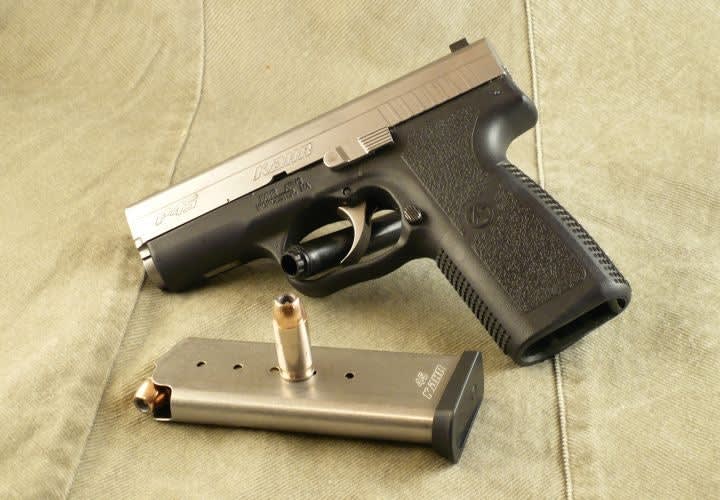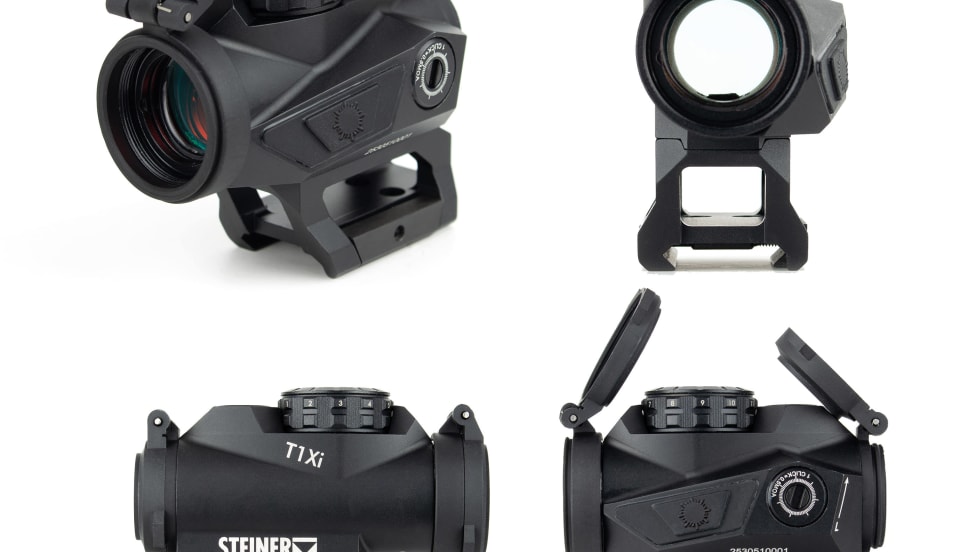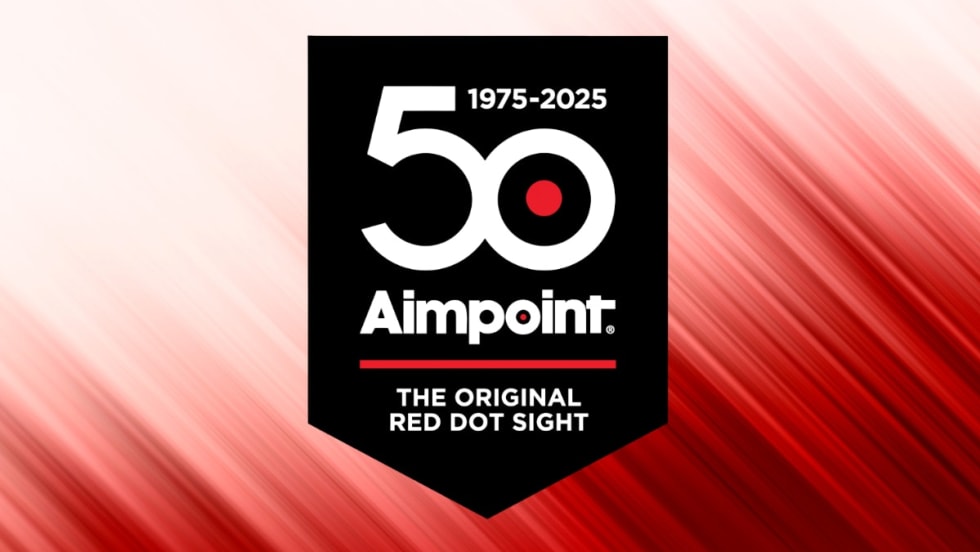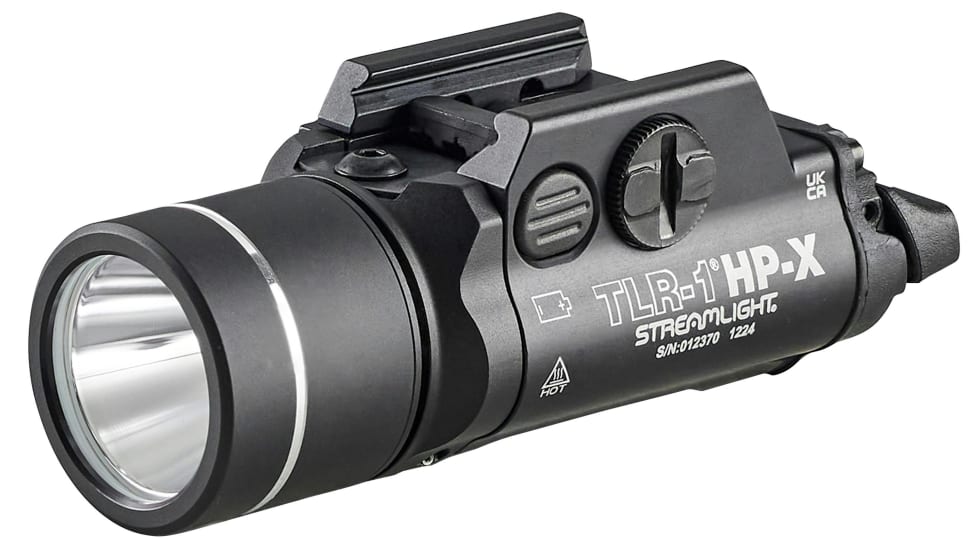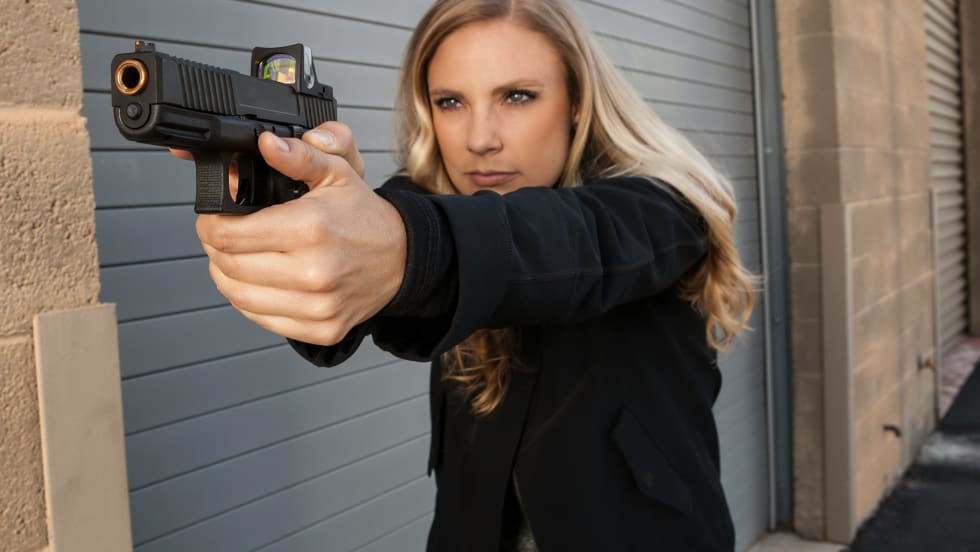Life is full of compromises. This has been especially true for those that have faced the perplexing problem of selecting an off-duty, undercover, or backup gun.
Weight and size are usually the determining factors in making this difficult decision. And while the .45 ACP cartridge has accumulated an impressive record as a proven fight-stopper, the guns chambered for this mighty round are usually bigger and heavier than most officers want to carry off duty or as a backup gun.
This is where the compromise is usually made. Downsizing the gun to make it more concealable often means settling for a smaller cartridge. But maybe such compromise is no longer necessary.
Kahr Arms has just introduced the P45, a polymer-framed .45 ACP semi-auto pistol. Weighing a feathery 18.5 ounces, the P45 is bound to make the decision-making process a little easier for fans of the big .45 cartridge.
Development Path
Kahr engineers made their first prototype of the P45 a few years back by cutting two steel-framed K9 pistols in half and welding in a spacer. Feedback from industry people and focus groups was invaluable in determining the path this project would follow. Folks wanted a lighter gun, despite its impressive bore size, and it was determined that the gun would have to be made with a polymer frame.
This development path is not unlike the one that Kahr followed with its original K9. Introduced back in 1995, the gun was an immediate hit due to its small size. Chambered in 9mm, it was about the size of most .380s. In fact, the only real criticism that people had of the K9 was that its all steel construction made it heavy for a 9mm.
So Kahr decided to make the gun lighter. The company briefly experimented with an alloy frame, which was abandoned when it was found that the frames were cracking after a few thousand rounds. The engineers then turned their attention to polymer and the P9 was born.
The P9 was an immediate hit because of its size and its light weight. The P9 was soon followed by the hugely popular subcompact PM9. Then came the P40 and PM40, both in .40 S&W. The .40 caliber pistols were hits, so Kahr's engineers set their sights on producing a lightweight, compact .45.
I first saw a prototype of the P45 about a year-and-a-half ago, but because Kahr wanted to make sure that the gun was absolutely right it waited until last fall to begin production.
I've had a chance to fire this gun quite a bit over the last few months, and I have come to the conclusion that it was well worth the wait.
Family Resemblance
If you're familiar with the Kahr family of weapons, there is nothing glaringly new or noteworthy about the P45. It features the same DAO trigger that Justin Moon designed for the very first Kahr offering, the K9. The pistol is a hammerless design, using a striker that is preloaded when the slide cycles. The smooth double-action trigger pulls the striker all of the way to the rear and releases it. Each pull of the trigger is exactly the same, from the first shot to the last.
There's about a quarter inch of very light take-up before the user encounters resistance, then another 3⁄8-inch of travel. My test sample required just under five pounds of pressure to push the trigger through its arc. There are no external safeties on the P45 or any of the Kahr pistols for that matter. Accidental discharges are supposed to be prevented by the relatively long trigger pull.
The gun sits low in the hand, like the rest of the Kahr pistols. Instead of putting the trigger action underneath the chamber end of the barrel, like most companies do, Kahr decided to offset the feedramp so the trigger mechanism could ride next to it. The result is that the bore's axis is very close to the hand. Guns with a high bore axis have more pronounced muzzle flip, whereas the Kahr design means quicker follow-up shots. This is especially important for a gun chambered for the powerful .45 ACP cartridge.[PAGEBREAK]
User Friendly
Another detail that makes the P45 comfortable to shoot despite its chambering is its grip. Grip width is just .99 inches and its circumference is 4.6 inches. Compared to a Colt .45 with wood grips that is 1.26 inches wide and 5.4 inches in circumference, the P45 grip is 15 percent smaller in circumference and the grip is more than 21-percent thinner. This means that even shooters with smaller hands and short fingers will be able to manipulate the P45 with ease.
I found that its front strap is long enough that I was able to fit all three fingers on it comfortably and without having to hang my pinky under the magazine floorplate. The front and back straps feature raised grenade-style checkering that's sharp enough to provide a good shooting grip but does not seem like it would hang up on clothing if it were being worn concealed. Side panels are textured with a small pebble pattern. The back strap is gently arched and provides the shooter with a comfortable grip angle that makes the P45 a natural pointer.
Kahr molds a stainless steel insert into the P45's polymer frame. Its purpose is to ensure that there is no steel-to-polymer contact anywhere along the slide's travel that would affect its service life.
If you look at the pictures that accompany this article, you can see that there is a groove in the slide's dust cover. These bilateral grooves engage the stainless steel rails that are molded into the frame's dust cover, in essence giving it a track to ride on. At the back of the frame's rails are two more blocks of stainless steel that the slide rides on.
One concession that Kahr's engineers had to make for the heavier recoiling .45 ACP chambering is that the magazine release on the P45 is made from steel. I was glad to see them make this move. It wouldn't surprise me if Kahr were to start using this steel magazine release in its .40 S&W guns also.
For corrosion resistance Kahr uses a stainless steel slide on the P45. Its width is just a hair over an inch, making the slide just a tiny bit wider than the grip. It has an eye-pleasing contour and has been relieved of any sharp edges, so it's ready for concealed carry straight out of the box.
The P45 uses an external extractor that also serves as a tactile loaded chamber indicator. When the gun has a loaded chamber, the extractor projects out slightly from the slide and can easily be felt with the trigger finger.
Like Glock and SIG firearms, the Kahr P45 uses a Browning-inspired dropping breechblock to achieve lock-up of the barrel and slide. A single recoil spring of stout tension is used on the P45, and it also uses a full-length recoil spring guide rod.
Both the front and rear sights are dovetailed into the slide. The rear sight can be drifted in its dovetail for windage adjustment. There is no provision for elevation adjustment, but I didn't find this to be an issue, as the sights were well regulated from the factory. The sights feature the popular bar-dot arrangement for quick alignment but Meprolight night sights are available for the P45 for an extra $110.
Shooting Impressions
By now I'm sure you're wondering how a .45 ACP that weighs just 18.5 ounces (unloaded and without the magazine) shoots. That was a huge concern of mine also, as the weight of the P45 is almost exactly half of what a steel-framed, full-size 1911 weighs.
Unfortunately, Kahr's engineers have not figured out a way to change the laws of physics. A gun that weighs just a pound and a quarter that's chambered for the potent .45 ACP cartridge is bound to get your attention when you touch it off. But one thing that helps quite a bit is that the bore is relatively low to the hand. Shooting the P45 is not painful, but it is harder to control than heavier guns. [PAGEBREAK]
On a good day, with a steel-framed 1911, I can place two quick hits on a steel target at 12 yards with a split-time between shots-of about 25⁄100 of a second. With the Kahr, my splits averaged 43⁄100 of a second. That's a significant amount of time, and this should be factored into your decision if you want to carry a lightweight .45. Nothing comes without a price and a certain amount of controllability is sacrificed for the weight savings.
Still, the accuracy of the P45 surpassed what I had expected from this lightweight auto, and it possesses more than enough precision for its intended mission. I was able to print two groups, with two different ammunitions, under 1.5 inches at 15 yards. My selection of loads consisted of defense ammunition that is on the hot side and, despite this, there were no failures of any type during the course of my 700-round evaluation.
Disassembly of the P45 for routine cleaning and lubrication is simple and requires no tools. On the left side of the frame and slide are dimples. By lining up these two witness marks, you can push out the slide stop. Pulling the trigger allows the slide to be pulled forward off of the frame. The recoil spring assembly can be removed from the slide by pushing the guide rod forward and lifting it out of the slide. The barrel can then be withdrawn from the slide. That's as far as you'll ever need to disassemble your P45 for normal cleaning and reassembly is accomplished in reverse order.
The Kahr P45 comes with two six-round stainless magazines. It's interesting to note that the plastic follower has a steel pin molded into it where it contacts the slide stop to prevent any undue wear that might be caused by plastic to steel contact. The magazines also possess a very strong spring that forces each new round up with gusto and prevents a whole host of feed maladies associated with a sluggish magazine spring.
Is the Kahr P45 the right gun for you? That depends. If your needs require the maximum amount of horsepower in the lightest weight platform possible, the P45 is worth taking a very hard look at.
Some will doubtlessly feel that the P45's 6 + 1 capacity is inadequate, but let me remind those folks that it still has two more rounds than a Chiefs Special, and we're talking .45 ACP here, not .38 Special. Others will find the P45 too difficult to control because of its light weight and potent caliber.
Fans of the .45 ACP cartridge tend to be the types that won't mind indulging in a little extra range time needed to learn to control the P45. As I said earlier, life is full of compromises, but it turns out that the Kahr P45 isn't really that big of a compromise after all.


